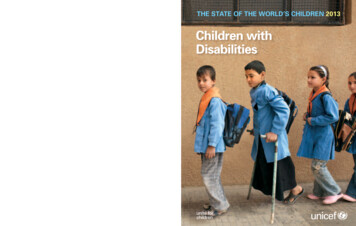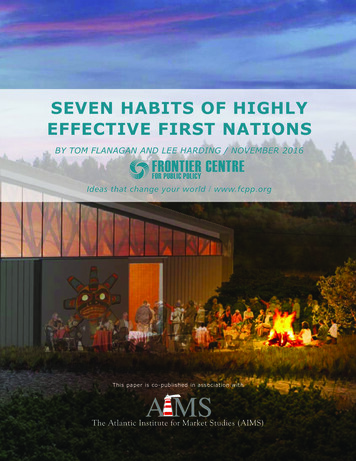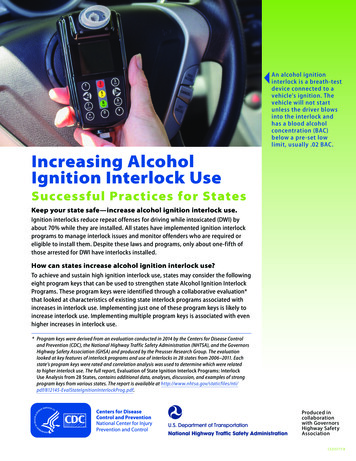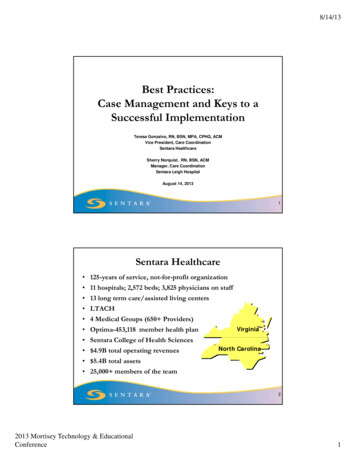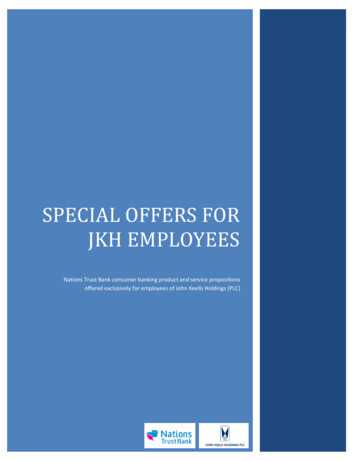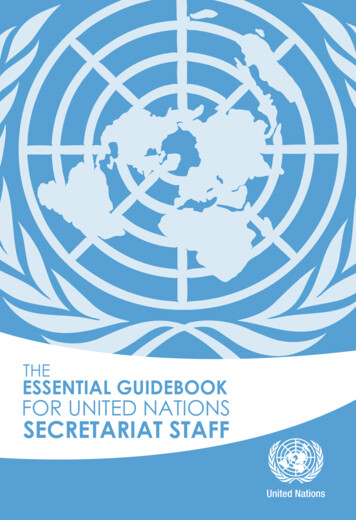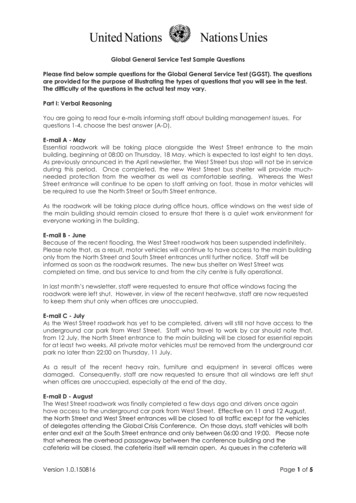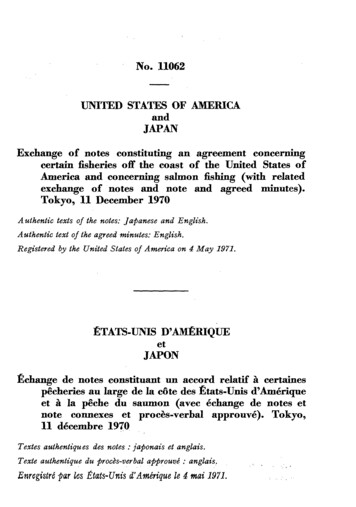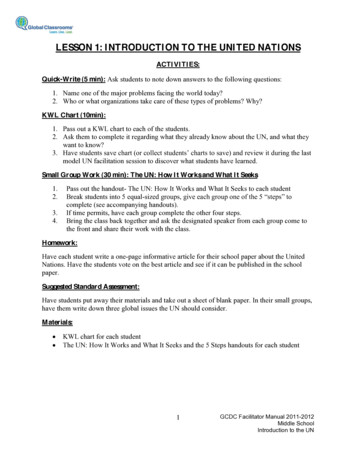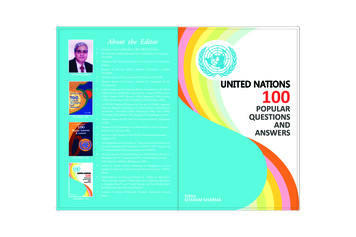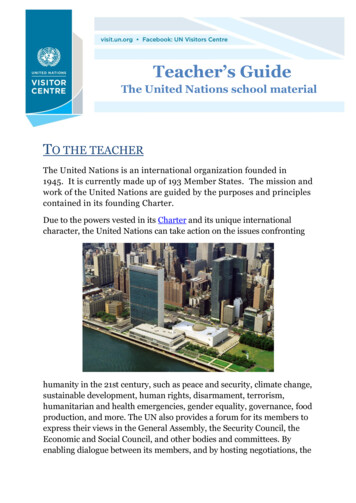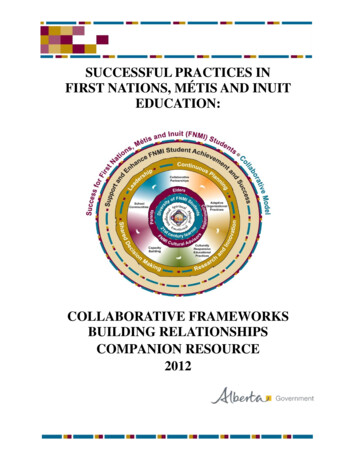
Transcription
SUCCESSFUL PRACTICES INFIRST NATIONS, MÉTIS AND INUITEDUCATION:COLLABORATIVE FRAMEWORKSBUILDING RELATIONSHIPSCOMPANION RESOURCE2012
Successful Practices in FNMI Education:Collaborative FrameworksBuilding Relationships CompanionResourceii /Collaborative Frameworks—Building Relationships Companion Resource 2012 Alberta Education, Alberta, Canada
For further information, contact:First Nations, Métis and Inuit Services and Field Services SectorAlberta Education9th Floor, 44 Capital Boulevard10044 – 108 Street NWEdmonton, Alberta T5J 5E6Telephone: 780-415-9300 in Edmonton or toll-free in Alberta by dialing 310-0000Fax: 780-415-9306Available online: workAll images are Crown-owned.Links to external resources included in Successful Practices in First Nations, Métis and Inuit Education:Collaborative Frameworks—Building Relationships Companion Resource may or may not be recommended orauthorized by Alberta Education. Users should verify websites and other resources mentioned prior to using themwith students.Copyright 2012, the Crown Right of Alberta, as represented by the Minister of Education. Alberta Education,First Nations, Métis and Inuit Services and Field Services Sector, 9th Floor, 44 Capital Boulevard, 10044 – 108Street NW, Edmonton, Alberta, Canada, T5J 5E6.Every effort has been made to provide proper acknowledgment of original sources. If cases are identified where thishas not been done, please notify Alberta Education so appropriate corrective action can be taken.Permission is given by the copyright owner to reproduce this document for educational purposes and on a nonprofitbasis, with the exception of materials cited for which Alberta Education does not own copyright.Permission is also granted for sharing the electronic files via the network capabilities at the school or jurisdictionlevel.ISBN 978–1–4601–0649–5
Table of ContentsIntroduction 1Collaborative Frameworks: Building Relationships 3Collaborative Frameworks: Themes 7Collaborative Partnerships 11Adaptive Organizational Practices 14Culturally Responsive Educational Practices 16Capacity Building 21School Communities 24Appendix A: Laying the Foundation 28Appendix B: Glossary 31Appendix C: Report on Introductory FNMI Engagement Workshops (2010) 33Appendix D: Roll-up of FNMI Engagement Workshops (2011) 56Appendix E: FNMI Traditional Parenting Skills Workshop Module: Facilitator Guide 66Appendix F: FNMI Cultural Awareness for Administrators Workshop Module: Facilitator Guide 86Endnotes 110References 119Collaborative Frameworks—Building Relationships Companion Resource 2012 Alberta Education, Alberta, Canada/1
IntroductionNote: When reading this document electronically, feel free to click on blue underlined words togo to the document cited.Success for First Nations, Métis and Inuit StudentsFirst Nations, Métis and Inuit peoples have long understood learning and education as a lifelongstriving for balance and wholeness among the physical, emotional, intellectual and spiritualdimensions, with each community having its own unique goals and vision for the educationalsuccess of its children.As part of Alberta’s Commission on Learning, Mackenzie (2009) writes, “ there needs to be ashared commitment and unrelenting effort from all stakeholders to ensure that every child learnsand that every child succeeds.”1 All Alberta students, including First Nations, Métis and Inuit,require support and learning opportunities to develop the knowledge, skills and attitudes neededfor full participation in an enriched society and sustainable economy. Inspiring Education: ADialogue with Albertans (2010) captures the vision of Albertans in response to the challenge ofadequately preparing each student for our rapidly changing economy and technological world.The Framework for Student Learning (2011) builds on this work by highlighting theinterrelationships between literacy, numeracy, competencies and subject/discipline areas that areessential for students to become engaged thinkers and ethical citizens with an entrepreneurialspirit. To support this, schools can create learning opportunities that engage students in: critical thinking, problem solving and decision making;creativity and innovation;social, cultural, global and environmental responsibility;communication;digital and technological fluency;lifelong learning, personal management and well-being; andcollaboration and leadership.Since implementing the First Nations, Métis and Inuit Education Policy Framework in 2002, theGovernment of Alberta has been committed to success for First Nations, Métis and Inuit studentsby helping to ensure they have every opportunity to succeed. In support of this commitment,Alberta Education continues to develop an ongoing dialogue with First Nations, Métis and Inuitcommunities and other education stakeholders.2Over the years, Alberta Education has incorporated collaborative practices for all schools toimprove First Nations, Métis and Inuit student success. This has been essential in buildingstronger relationships among stakeholders and deepening an understanding of First Nations,Métis and Inuit peoples, histories, cultures and languages. In Sharing Our Success, Bell et al.(2004) writes, “Many studies have shown that strong working partnerships between schools,parents, and communities exert a powerful positive influence toward improved schoolperformance.”32/Collaborative Frameworks—Building Relationships Companion Resource 2012 Alberta Education, Alberta, Canada
Since 2009, Alberta school authorities have been implementing Goal 3: Success for FirstNations, Métis and Inuit Students, developing collaborative frameworks with their local FirstNations, Métis and Inuit communities, and implementing community and parent strategiesfocused on improving FNMI student success. During this time, the First Nations, Métis and InuitServices and Field Services Sector have been working on the development of the CollaborativeFrameworks, together with input from First Nations, Métis and Inuit stakeholders, schoolauthorities and with consideration of research.Collaborative Frameworks Building RelationshipsThe Collaborative Frameworks serves as a guide to strengthen collaborative processes betweenschool authorities, parents, communities and other stakeholders, as they work together toimprove the educational outcomes of First Nations, Métis and Inuit students.The digital model of the Collaborative Frameworks was designed in partnership with AlbertaEducation and the Alberta Regional Professional Development Consortia. The model serves asan implementation tool to support school authorities as they develop their own First Nations,Métis and Inuit education frameworks and/or evaluate their existing supports.In addition, the collaborative partnership with the Alberta Regional Professional DevelopmentConsortia provided workshop opportunities to address changing demographics and explore waysto increase the participation of local First Nations, Métis and Inuit families, parents andcommunities in schools. Fourteen First Nations, Métis and Inuit Introductory Workshops onEngagement (see Appendix C) were held across the province. Each of the workshops followedlocal protocols to respect cultural rights and to promote respectful sharing between schoolauthorities and First Nations, Métis and Inuit families, parents and communities. Feedback fromworkshop participants included: “Understanding your role as a parent is important. What responsibilities belong to me?What are my rights?” “ provide schools with contacts—parents or Elders who can advocate for the system toincrease engagement.” “ just because parents don't get involved does not mean they don't care.” “ the FNMI voice has been heard throughout the province of Alberta and schooljurisdictions will have indicators as to the improvement of FNMI parent engagement.” “ the need to develop specific workshops for FNMI parents regarding the educationsystem, such as increasing knowledge of traditional parenting skills, racism, the historicaltrauma of residential, and right and responsibilities of parents.”Collaborative Frameworks—Building Relationships Companion Resource 2012 Alberta Education, Alberta, Canada/3
“ the fact the Introductory Report is involving parents, communities and families. It’snot just the people in the high positions making the decisions. Big step!” “ educate culturally sensitivity to principals and administrators.” “ look for ways to enhance community relationships—try different approaches to makean idea work.”Other workshop feedback recommended that resources be developed to support the existingCollaborative Frameworks to strengthen collective First Nations, Métis and Inuit voices,showcase positive results and identify ongoing issues. Further resources could also model otherschool authorities’ best practices in implementing the Collaborative Frameworks and includeways to ensure that appropriate teaching and learning material reflects the views of First Nations,Métis and Inuit peoples and organizations.An introductory video was also produced to reflect on the successes and challenges from theperspectives of First Nations, Métis and Inuit coordinators, superintendents and directors ofeducation, Elders, principals, teachers, Alberta Education staff and First Nations, Métis and Inuitfamilies, parents and community members. Each interview contains key messages and particularstrategies that can be considered and implemented by school authorities as a means of improvingFNMI student success. The video also represents a collective effort to address the importance ofa continuous planning process where First Nations, Métis and Inuit stakeholders andcommunities have a voice in shared decision making and common understanding to support theCollaborative Frameworks.4/Collaborative Frameworks—Building Relationships Companion Resource 2012 Alberta Education, Alberta, Canada
Click on the digital collaborativemodel sidebar under videos to viewthe 20-minute video in its entiretyCollaborative Framework EngagementCulturally Responsive Practices/TeacherProfessional DevelopmentShared Responsibility/Ownership ofCollaborative FrameworkFirst Nations Collaboration/VisioningCapacity Building/Teacher ProfessionalDevelopmentPositive Community Engagement/Culturally Responsive EducationFNMI Cultural Advisors/LeadershipShared Decision Making based onPartnershipsCommunity EngagementCommunicate Collaborative FNMISchool/Community PracticesSustaining Successful FNMISchool/Community PracticesContinuous Planning/First NationsCollaborationResearch and Evidence: Impacts ofResidential SchoolingCulturally Responsive/Local ResourcesShared Vision for FNMI StudentSuccessCollaborative Partnerships/MétisSettlements: Families, Parents andCommunityLeadership/EldersCulturally ResponsiveEducation/Teacher ProfessionalDevelopmentLocal Continuous Planning/ParentCouncilCollaborative Network in FNMICommunitiesPositive Relationships/Celebrating FNMIStudent SuccessCollaborative Frameworks—Building Relationships Companion Resource 2012 Alberta Education, Alberta, Canada/5
First Nations, Métis and Inuit Families, Parents and Community EngagementAlberta’s Commission on Learning (2003) reports that the best approach is to encourage FNMIto take more control of their children’s education. “Aboriginal people–especially parents, Eldersand community leaders–need to be empowered to take ownership of and responsibility for theeducation of their children.”4 Despite many challenges, some schools are beginning to showprogress in working with First Nations, Métis and Inuit parents and communities towardimproving the educational outcomes of their children.To ensure engagement and approval of the Conceptual Collaborative Frameworks, Treaty 6, 7and 8, First Nations and Métis educational partners and communities spent a full day inMarch 2010 refining and further developing common understandings for the content. FNMIcommittee members contributed and provided advice on the development of workshops andresources.To build capacity and promote success for First Nations, Métis and Inuit students at thecommunity level, 16 workshops were held across the province in 2011. The report from thesesessions, Roll-up of FNMI Engagement Workshops (2011) (see Appendix D), affirmed the needto continue building collaborative partnerships between schools, parents, communities,organizations and government agencies. The report also identified the need for consistentdirection and leadership and continued efforts in seeking partnerships between home andcommunity and school and authority. Parent and administrator training modules were developedto promote respect and appreciation of local First Nations, Métis and Inuit knowledge, skills andattitudes. The objectives of the modules and workshops include the following: FNMI Traditional Parenting Skills Workshop Module: Facilitator Guide(see Appendix E) To raise awareness and understanding among parents and school authorities aboutFirst Nations, Métis and Inuit traditional parenting skills and their implications forstudent success in school, based on diversity and respect for local protocols. To advocate and support increased parental involvement and improved participation. FNMI Cultural Awareness for Administrators Workshop Module: Facilitator Guide (seeAppendix F) To support administrators in developing First Nations, Métis and Inuit culturalawareness to support improved student success in school, based on diversity andrespect for local cultural process. To support administrators in advocating increased First Nations, Métis and Inuitcultural awareness among their staff and in their schools.Many participants who attended the workshops were very encouraged and felt supported by thelearning outcomes of resource materials. Once again, Alberta Education heard that more isneeded for implementation support in order to continue
school authorities’ best practices in implementing the Collaborative Frameworks and include ways to ensure that appropriate teaching and learning material reflects the views of First Nations, Métis and Inuit peoples and organizations. An introductory video was also produced to reflect on the successes and challenges from the perspectives of First Nations, Métis and Inuit coordinators .
